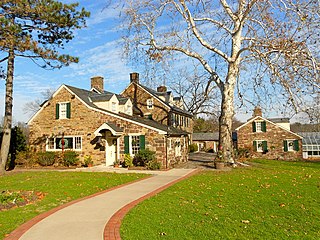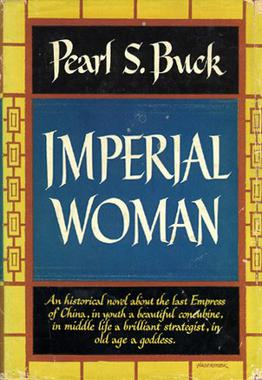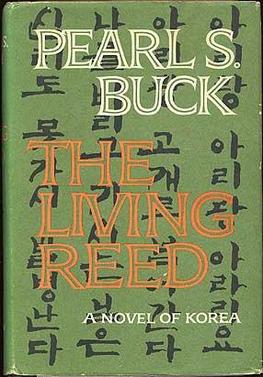
A mandala is a geometric configuration of symbols. In various spiritual traditions, mandalas may be employed for focusing attention of practitioners and adepts, as a spiritual guidance tool, for establishing a sacred space and as an aid to meditation and trance induction. In the Eastern religions of Hinduism, Buddhism, Jainism and Shinto it is used as a map representing deities, or especially in the case of Shinto, paradises, kami or actual shrines. A mandala generally represents the spiritual journey, starting from outside to the inner core, through layers.

Pearl Comfort Sydenstricker Buck was an American writer and novelist. She is best known for The Good Earth, the best-selling novel in the United States in 1931 and 1932 and which won her the Pulitzer Prize in 1932. In 1938, Buck became the first American woman to win the Nobel Prize in Literature "for her rich and truly epic descriptions of peasant life in China" and for her "masterpieces", two memoir-biographies of her missionary parents.

The Good Earth is a historical fiction novel by Pearl S. Buck published in 1931 that dramatizes family life in a 20th-century Chinese village in Anhwei. It is the first book in her House of Earth trilogy, continued in Sons (1932) and A House Divided (1935). It was the best-selling novel in the United States in both 1931 and 1932, won the Pulitzer Prize for Fiction in 1932, and was influential in Buck's winning the Nobel Prize for Literature in 1938. Buck, who grew up in China as the daughter of American missionaries, wrote the book while living in China and drew on her first-hand observation of Chinese village life. The realistic and sympathetic depiction of the farmer Wang Lung and his wife O-Lan helped prepare Americans of the 1930s to consider Chinese as allies in the coming war with Japan.

The Guide is a 1958 novel written in English by the Indian author R. K. Narayan. Like most of his works, the novel is based on Malgudi, the fictional town in South India. The novel describes the transformation of the protagonist, Raju, from a tour guide to a spiritual guide and then one of the greatest holy men of India.
A son is a male offspring in relation to a parent.

The Pearl S. Buck House, formerly known as Green Hills Farm, is the 67-acre homestead in Bucks County, Pennsylvania, where Nobel-prize-winning American author Pearl Buck lived for 40 years, raising her family, writing, pursuing humanitarian interests, and gardening. She purchased the house in 1933 and lived there until the late 1960s, when she moved to Danby, Vermont. She completed many works while on the farm, including This Proud Heart (1938), The Patriot (1939), Today and Forever (1941), and The Child Who Never Grew (1950). The farm, a National Historic Landmark, is located on Dublin Road southwest of Dublin, Pennsylvania. It is now a museum open to the public.

Peony, published in the UK as The Bondmaid, is a novel by Pearl S. Buck first published in 1948. It is a story of China's Kaifeng Jews.

Imperial Woman is a novel by Pearl S. Buck first published in 1956.
Mandala is a geometric configuration of symbols used in various spiritual traditions.

The Big Wave is a children's novel by Pearl S. Buck, first published as a short story in the October 1947 issue of the magazine Jack and Jill with illustrations from Ann Eshner Jaffe. Buck expanded the story and published it in book form in 1948 through John Day Company, with illustrations from Utagawa Hiroshige and Katsushika Hokusai.

The Living Reed is a historical novel by Pearl S. Buck. It describes life in Korea from the latter part of the nineteenth century to the end of the Second World War through the viewpoints and lives of several members of four generations of a prominent aristocratic family.

Fighting Angel: Portrait of a Soul (1936) is a memoir, sometimes called a "creative non-fiction novel," written by Pearl S. Buck about her father, Absalom Sydenstricker (1852–1931) as a companion to her memoir of her mother, The Exile.

The Mandala of Sherlock Holmes is a Sherlock Holmes pastiche novel by Jamyang Norbu, originally published in India in 1999.
John Lossing Buck was an American agricultural economist specializing in the rural economy of China. He first went to China in 1915 as an agricultural missionary for the American Presbyterian Mission and was based in China until 1944. His wife, whom he later divorced, was Nobel Prize-winning author Pearl S. Buck (1892–1973).
Pratibha Satpathy is a poet of Odia literature. She has been recognised as one of the leading poets of the country and has been honoured with the Sahitya Akademi Award.
The Mother is a novel by Pearl S. Buck published in 1934. It features an unnamed peasant woman in rural, pre-revolutionary China.

Dragon Seed styled as Dragon Seed: A Novel of China Today is a novel by Pearl S. Buck first published in 1942. It describes the lives of Chinese peasants in a village outside Nanjing, China, immediately prior to and during the Japanese invasion in 1937. Some characters seek protection in the city while others become collaborators. This story focuses less on the details of the attack and more on the characters’ reactions to the events in Nanking. The Nanking Massacre involved months of horrific violence by the Imperial Japanese Army as they conquered the city; the novel takes place during these events. Buck opines in the novel that Japanese troops passing through China feel no responsibility for their conduct as they won’t be present to be confronted after the violence is over.

Christine is a musical by Pearl S. Buck and Charles K. Peck Jr. (book), Paul Francis Webster (lyrics) and Sammy Fain (music). Loosely based on the 1945 novel My Indian Family by Hilda Wernher, it tells the story of a woman who travels to India where she ends up falling in love with her recently widowed Indian son-in-law. Notable for the involvement of Pulitzer & Nobel prize winning author Pearl S. Buck, the musical premiered on Broadway in 1960.

The 1938 Nobel Prize in Literature was awarded to the American author Pearl S. Buck (1892–1973) "for her rich and truly epic descriptions of peasant life in China and for her biographical masterpieces." Buck was the first female American to be awarded the Nobel Prize and the third American recipient following Eugene O'Neill in 1936 and Sinclair Lewis in 1930. She was also the fourth woman to receive the prize.












